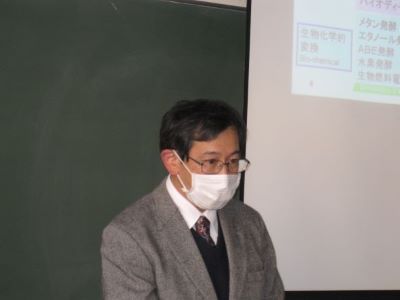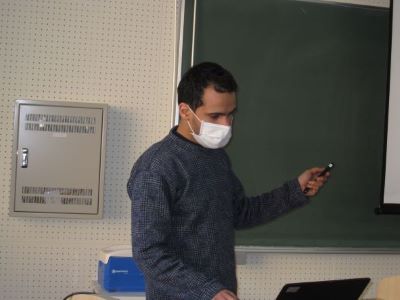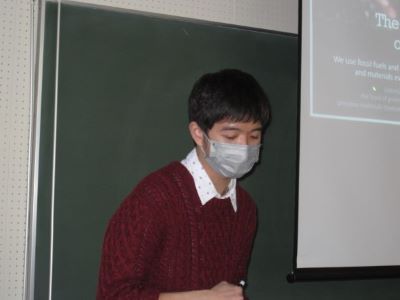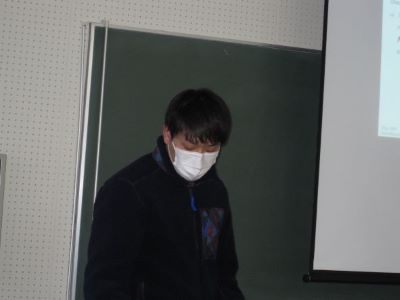HOSTY Association (Graduate School of Advanced Science and Engineering)
Email: bprc*hiroshima-u.ac.jp (Please replace*with @)
Date & Time: Wednesday 16 February, 2022 16:20-17:50
Place: Engineering 110 Lecture Room, Higashi-Hiroshima Campus, Hiroshima University
Program
Chair & Commentary: Yukihiko MATSUMURA
Professor, Graduate School of Advanced Science and Engineering, Hiroshima University

Lecture: Ali Mohammed Ahmed MOHAMMED
D1 student, Graduate School of Advanced Science and Engineering, Hiroshima University
“Gasification of Glucose in Supercritical Water Using Carbon Nanotube Catalyst”
Among carbonaceous nanoparticles, carbon nanotube (CNT) is a possible biomass catalyst or a catalyst support. Nanocarbon should be more effective than conventional activated carbon catalysts, because of its nanostructure and a high specific surface area. In this study, glucose was used because it is a typical model compound of biomass. Ruthenium with CNT has been prepared and placed in the packed bed reactor located at the entrance of the reactor. The concentration of glucose was 5 wt%, the residence time, pressure and temperature were fixed at 94 s, 25 MPa and 600 °C, respectively.

Lecture: Rittanupap THAVORN
D1 student, Graduate School of Advanced Science and Engineering, Hiroshima University
“The estimation of product yield from the hydrothermal carbonization process using feedstock as the mixture of cellulose, lignin, and xylose and each component”
Hydrothermal technology has been the spotlight for highly efficient conversion technology due to there is no limit to the moisture content for biomass during the hydrothermal process. There is no universal model to predict the behavior of different feedstock under HTC conditions. So, this study aims to compare yield from hydrothermal carbonization of the mixture of cellulose, lignin, and xylose and individual components to check the yield’s predictability from the composition and understand the mechanism toward the reaction. The experiment handled the hydrothermal carbonization (HTC) of feedstock at 200 to 280°C with many trials of feedstock components. The result indicates that the hydrochar product showed a decreasing trend of solid product mass yield at the higher temperature of carbonization, which initially started from 32.9 to 22.7% in a mixture of cellulose, lignin, and xylose. Finally, in predicting hydrochar product value, we found a 15.78 % error in the prediction value and experimental value of the hydrothermal carbonized mixture of cellulose, lignin, and xylose at 280°C.

Lecture: Kaisei TAKEMURA
D3 student, Graduate School of Integrated Sciences for Life, Hiroshima University
“Enhancing acetone productivity from H₂/CO₂ of the metabolically engineered thermophilic acetogen Moorella thermocatica by anaerobic respiration”
Gas fermentation utilizing hydrogen (H₂) and carbon dioxide (CO₂) is an attractive process because it can directly convert CO₂, a causative agent of global warming, to valuable materials. We previously engineered a thermophilic acetogen, Moorella thermoacetica, to produce acetone from H₂/CO₂. Although the productivity was low, it was suggested that the productivity could be enhanced by improving the ability of adenosine triphosphate (ATP) synthesis. This study attempted to utilize anaerobic respiration to increase ATP production and investigated its effect on acetone productivity.

Lecture: Naoki WATANABE
M1 student, Graduate School of Integrated Sciences for Life, Hiroshima University
“Development of practical production technology of acetate from H₂/CO₂ by Acetobacterium woodii”
A large amount of carbon dioxide (CO₂) emissions due to excessive dependence on fossil fuels has become a major problem. One of the ways to solve this problem is to make effective use of CO₂ emissions. Acetobacterium woodii produces acetate by using hydrogen (H₂) as an energy source to capitalize on CO₂. In this research, this feature is applied as a manufacturing technology that contributes to the effective use of CO₂ emissions, and we aim to put it to practical use by investigating of medium composition for low cost production of acetate and increasing the speed of acetate production.


 Home
Home














